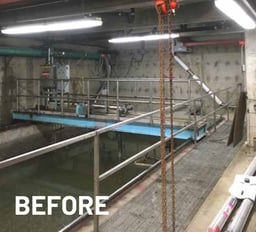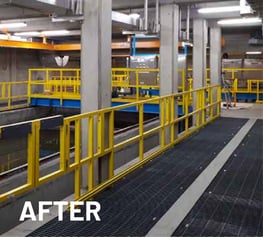High-performance plastics at the heart of a wastewater treatment plant
The modernization and expansion of a wastewater treatment plant in Magog aimed to increase its capacity by building new tanks and replacing structures such as floors, walkways, railings and ladders.
Challenges
 Wastewater treatment plants are very demanding environments. Constant contact with water combined with high humidity levels creates corrosion and reduces the service life of structural components.
Wastewater treatment plants are very demanding environments. Constant contact with water combined with high humidity levels creates corrosion and reduces the service life of structural components.
Structures affected by rust lose their mechanical properties, requiring more maintenance and increasing the risk of work-related accidents. In this case, it was necessary to replace these structures, since the traditional materials used in the construction of the plant were worn and heavily corroded.
Solution
 To select the right material for your structures, environmental constraints must be factored in. In the case of wastewater treatment plants, replacing steel structural components with FRP (fibre-reinforced plastic) equivalents is an effective and durable solution that prevents corrosion and premature wear.
To select the right material for your structures, environmental constraints must be factored in. In the case of wastewater treatment plants, replacing steel structural components with FRP (fibre-reinforced plastic) equivalents is an effective and durable solution that prevents corrosion and premature wear.

Advantages of choosing FRP for your structures:
- Rust proof
- Superior service life
- Excellent chemical resistance, which is ideal for humid environments and those where structural components come in contact with corrosive products
- Excellent mechanical properties
- 70% lighter than steel
- Does not need to be welded, can be installed very quickly and is easy to maintain
- Available with a non-slip finish that reduces the risk of falls
- Fire retardant, non-conductive and does not interfere with radio waves and electrical signals
Results
 Fibre-reinforced plastic was the perfect choice to replace the safety guards and the platform floor that surrounds the plant's water treatment tanks.
Fibre-reinforced plastic was the perfect choice to replace the safety guards and the platform floor that surrounds the plant's water treatment tanks.
Compared to traditional materials, FRP has a long service life and offers superior corrosion resistance. Moreover, FRP distinguishes itself in a humid environment thanks to its anti-skid property, an important factor in terms of workplace safety. In addition, FRP is lightweight and easy to install, greatly facilitating the assembly process.
The proven effectiveness of FRP
.png?width=100&name=secure%20(4).png) The strength of fibre-reinforced plastic makes it a material of choice and an excellent alternative to metals. Mainly used by the chemical and oil industries, it also finds its way into food processing plants and power plants. The most popular applications for FRP are ladders, stairs, walkways and railings. Easily visible, FRP does not need to be painted nor does it require special maintenance.
The strength of fibre-reinforced plastic makes it a material of choice and an excellent alternative to metals. Mainly used by the chemical and oil industries, it also finds its way into food processing plants and power plants. The most popular applications for FRP are ladders, stairs, walkways and railings. Easily visible, FRP does not need to be painted nor does it require special maintenance.
FRP is also available in food grade. To learn more about structural components designed for the food industry, see our articles:
FRP in the Food Sector
Durable and non-skid work structures for the food sector
High-performance plastics for all types of industries
.png?width=100&name=gear%20(2).png) Various industries are making increasing use of high-performance plastics to replace traditional materials. Since each material has its own unique properties, targeting the right plastic is critical. In the case of the Magog wastewater treatment plant, FRP was chosen over traditional materials for its performance in humid environments, durability, low maintenance requirements, and safety.
Various industries are making increasing use of high-performance plastics to replace traditional materials. Since each material has its own unique properties, targeting the right plastic is critical. In the case of the Magog wastewater treatment plant, FRP was chosen over traditional materials for its performance in humid environments, durability, low maintenance requirements, and safety.
To learn more about key elements to consider when choosing materials, check out our article,
4 Questions to Help You Choose the Right Structural Materials








